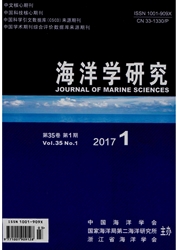

 中文摘要:
中文摘要:
2006年夏季、冬季和2007年春季、秋季在长江口及东海海域进行了大面积走航采样,通过离子色谱法分析了气溶胶中主要水溶性离子的质量浓度,探讨了其季节变化和海域分布。分析结果表明,K+和Ca2+季节变化显著,海域分布呈现近岸高外海低的趋势,Na+和Mg2+海域分布差异显著;NH4+-N,NO3--N和SO42--S的春、冬季节平均含量明显高于秋、夏季节,主要是由于春、冬季节盛行西北风,陆源物质大气输送明显;春季和冬季的甲基磺酸平均含量明显高于其他季节;苏北海区、长江口海区、杭州湾海区、舟山群岛海区和东海外海海区上空大气气溶胶中NO3-/nss-SO42-比值的全年平均分别为0.79,0.83,0.81,0.68和0.51,对比前人研究结果NO3-/nss-SO42-比值呈上升趋势。总体而言,陆源物质的大气输送和干、湿沉降导致长江口及东海海域大气气溶胶的化学组成呈现出明显的季节变化和陆源特征。
 英文摘要:
英文摘要:
In order to characterize the seasonal dynamics and regional distribution of major water-soluble ions in atmospheric environment,aerosols were sampled during summer and winter of 2006,and spring and autumn of 2007 in Changjiang River Estuary and East China Sea and analyzed by ion chromatography.The results reveals that K+ and Ca2+ in the atmospheric aerosol has significant seasonal variations,showing a trend of decreasing from the shore to open sea,while Na+ and Mg2+ shows obvious differences of regional distribution.Based on the differences of the sea conditions during the cruise,spring and autumn are selected for plotting,which shows that Na+ and Mg2+ are sea salt ions,while Ca2+ and K+ are non-sea salt ions.The average mass concentrations of NH+4-N,NO-3-N and SO2-4-S in spring and winter are significantly higher than those in autumn and summer,which is mainly due to the atmospheric transportation of terrestrial materials by the prevailing northwest wind in spring and winter.The overall distribution presents a gradual decrease from the shore seawards,indicating that the ions mass concentration was affected by anthropogenic emissions.Moreover,the mass concentration of methylsulphonic acid(MSA) in atmospheric aerosol shows a significant seasonal variation with the highest value in spring,which might be explained by the dimethyl sulfide(DMS) produced by algae growth getting into the aerosol through the sea-air interaction during spring plankton bloom.Finally,the ratios of atmospheric NO-3/nss-SO2-4(non-sea salt sulfate) in northern Jiangsu area,Changjiang River Estuary,Hangzhou Bay,Zhoushan Archipelago and East China Sea were 0.79,0.83,0.81,0.68 and 0.51,respectively,which presents an increasing trend if compared to the previous results.In summary,the atmospheric transportation and wet and dry deposition of the terrigenous materials result in obvious seasonal variations of the chemical composition of the atmospheric aerosol and its terrigenous characteristics.
 同期刊论文项目
同期刊论文项目
 同项目期刊论文
同项目期刊论文
 期刊信息
期刊信息
